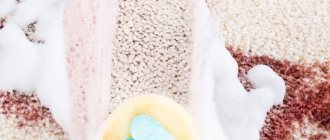Ceramic sinks are very popular and in demand. Practical and beautiful, they are characterized by resistance to wear and durability. However, many people believe that sinks made from this material are difficult to maintain. In fact, cleaning a ceramic sink is not a difficult task. The main thing is to choose the right composition and product for one type of dirt or another, and also follow simple recommendations for caring for the sink.
Daily care: rules
In order for a ceramic sink to maintain its aesthetics for a long time, it is important to regularly remove dirt from its surface. To accomplish this, water alone is not enough. For daily care it is worth using special chemicals (“Silit” or “Sif”). The best time to do this is at the end of the day, when tidying up the kitchen.
How to care for a ceramic sink? Basic daily rules include the advice to wipe dry after each use. To do this, you should get a special towel. It should be placed next to the sink. This way you will always have it at hand if you need to blot up moisture. You can make your daily care task easier by teaching your family members to wipe down the sink after themselves.
Rules that will help you maintain your sink
Any sink requires special care, and ceramic is no exception.
Despite the fact that it is quite durable, it is still necessary to follow certain rules:
- The very first and simplest thing is cleansing. Rinse with a regular damp cloth after each use or at least at the end of the day and do this daily - all this will help maintain the original appearance of the sink.
- It may seem that if the sink is resistant to high temperatures, then it is ok to run the water too hot. But such neglect can cause cracks, so you should still monitor the temperature of the released liquid.
- To avoid scratching the surface, do not use anything sharp. You also cannot throw any heavy objects at it, because... Despite the strength of ceramics, the sink can easily crack.
- If the sink suddenly gets damaged, you should urgently take it in for repairs (you shouldn’t try to fix it yourself, otherwise you might make things worse). The earlier the better.
Repairing the product is simple and any flaws are filled with a special substance.
Recommended chemicals
How to clean a ceramic sink so as not to damage the material and completely remove dirt? There is a wide range of household chemicals on supermarket shelves, but it is important to carefully study the composition. It should not contain abrasive particles that form scratches on the surface of the ceramic sink.
Suitable for daily sink care:
- Cillit Bang. This product removes plaque well. It comes in the form of a spray, so it is convenient to apply to the surface of the sink. This chemical is designed specifically for ceramics and glass ceramics. It can be used not only for cleaning the sink, but also for cooking surfaces. Cilit Bang is easy to use. You need to apply it to the surface, leave for a few minutes, wipe with a sponge, and rinse.
- Mellerud. Household chemicals of this brand are not yet very well known. But it’s worth remembering this product, because it not only carefully cleans porcelain tiles, but also cares for the surface. An ideal combination for daily care. With regular use, Mellerud forms a protective film on the surface of the sink, which prevents dirt from sticking. Its cost is relatively low, its efficiency is good, and its composition is safe for artificial stone.
- "Mr. Muscle" in spray. This composition not only cleans the ceramic surface, but also provides a disinfecting effect, killing almost 100% of bacteria. Due to its convenient spray form, the product penetrates even into cracks and corners and perfectly dissolves old stains. To use, you need to spray Mr. Muscle on the sink, leave for 5 minutes, wipe well with a sponge and rinse. If not all stains are removed, you can repeat the procedure.
It is very important to read the recommendations of household chemical manufacturers when choosing a cleaning product for a ceramic sink. The composition should not contain strong reagents that can corrode the structure of the material or deform it, and no abrasives. The latter scratches the surface, dirt quickly eats into the damage, and it is not easy to wash it later.
The ceramic sink cleaner is selected from those recommended for composites. Such compositions effectively remove dirt and do not form streaks.
What is the difference?
A porcelain stoneware sink in the kitchen has a number of advantages, in contrast to standard iron or cast iron ones. In addition to its beautiful appearance, this type of sink has the following characteristics:
- noise resistance - when the water flow is turned on, no noise is created;
- ease of restoration in case of severe damage;
- environmental friendliness - the material is made from natural stone chips;
- low level of interaction with liquids that are often used in the kitchen;
- resistance to moisture - the pores of the material do not allow water to pass through.
A good quality that housewives like is the low rate of bacterial growth on the surface of the sink. If constant moisture is present, unpleasant odor and mucus will not form. It is possible to order your own design to match the kitchen interior, because such sinks are made by pressing crumbs with an adhesive solution. But there is also a drawback: the dishes easily hit the porcelain stoneware.
Fighting specific stains
Contaminants on a ceramic sink can be of different nature: rust, plaque, dyes, grease. It’s not easy to deal with such stains, but you can choose special-purpose formulations from among the range of detergents. Therefore, the type and nature of contamination must be determined.
White limescale
It is nothing more than water salts that remain on the surface of the sink after the moisture has dried. You can avoid their appearance by installing a filter. Improving the quality of water means freeing it from salts, and less plaque is formed. If this is not done, white spots and stains will appear. They are not easy to remove, but it is possible.
How to remove plaque from a ceramic sink? You can use home methods:
- treating the washing surface with a bleach solution once a week. You need to close the drain hole, apply liquid, leave for 20 minutes, rinse with warm water and wipe dry;
- scrubbing away plaque stains using household bleach. Please note that this composition is quite aggressive. It is not recommended to use it more than once every 14 days. Before use, you will need to dilute it with water (1:3) and treat the sink with a spray bottle and leave overnight (up to 14 hours). Then wipe with a sponge and rinse with water;
- Vinegar is one of the first aides when cleaning a ceramic sink at home. It is simply applied to the surface, allowed to stand for 3 minutes and rinsed. For old stains, apply a cloth soaked in vinegar and leave for 15–20 minutes;
- ammonia. Another handy tool that will help remove limescale stains. How to clean a ceramic sink from plaque using ammonia? It's simple: you need to make a special composition from water and this product, adding a few drops per 200 ml of liquid. Apply the product to the sink, leave for 10 minutes and rinse off.
Although the list contains available means, when working with them, as with industrial compounds, you should adhere to safety rules. Before cleaning the sink, you need to wear gloves and a respirator. Caustic substances can cause ulcers on the hands, and toxic fumes can lead to poisoning or burns to the respiratory tract.
Removing traces of rust
Worn out taps and old fittings often lead to red spots appearing on sinks. This is rust. It distorts the beauty of a ceramic sink. If you leave stains, then over time they eat away, and it becomes very difficult to clean them. Therefore, it is worth removing contaminants literally immediately after they form. And home remedies will help with this.
How to clean a ceramic sink if it has rust? Remember effective recipes:
- A solution of peroxide and ammonia in proportion 1: The resulting product is applied with a sponge to the rust stain and left for a while. When the components are mixed, a chemical reaction occurs that helps clean the composite. Then you just need to rinse the sink with water. It is advisable to clean with ammonia and peroxide once a week so that rust does not have time to eat into the material.
- Coca-Cola + spray bottle. You may be surprised, but the world-famous drink perfectly cleanses the composite of contaminants. You need to spray Cola on the stains and leave for an hour. Next you will need to rub the stain with a sponge and rinse with water. The same method works for cleaning other delicate surfaces - acrylic, enamel. A few processing cycles - and there will be no trace of rust left.
In addition to a sponge and improvised means, it is worth stocking up on an old brush (toothbrush, for example). It is convenient to wipe off dirt from corrugated surfaces.
After cleaning the sink from rust, you should treat the surface with a vinegar solution. It will act as a disinfectant.
Removing traces of coffee
Stains from this drink, like tea, appear as yellowness. You can fight them with lemon juice. You just need to lubricate the contaminated areas with half the fruit, then rub and leave for a couple of hours.
When there is no citrus in the house, but there are stains from coffee and tea, you can use a concentrated solution of citric acid or store-bought products. For example, Pemolux will help. It is sold in powder, which must be diluted with plain water before use. Next, the paste should be applied to the surface of the sink and wait a little.
Fighting varnish stains
These are the most difficult contaminants. They cannot be removed with conventional detergents, which only smear the stain. You can remove nail polish or paint from a ceramic sink using White Spirit solvent.
You need to moisten a cloth or cotton swab in a chemical solution and wipe the stained areas. However, it is important to consider that the solvent is a very toxic and caustic substance. It can damage the surface of a ceramic sink, so it should be used carefully and in small quantities.
How to clean an artificial stone sink in the kitchen: tips with video
- treat the sink with dishwashing gel to remove grease;
- remove strong stains separately;
- apply cream or liquid to the walls and bottom;
- wait 15-20 minutes;
- wash off the product;
- Wipe the sink with a dry and soft cloth.
You can clean a stone sink at home using improvised means or special household chemicals. The following videos will help you understand the nuances of cleaning:
The most incredible way to get my hair back!
This is just a DISASTER ! And after all, my hair did not start falling out in one day, but systematically - day after day I watched how the hair left my head: while combing, washing, even while sleeping. (read more…)
Folk recipes
One of the characteristics of composite materials is ease of maintenance. You can clean household dirt from them using improvised means. There are many recipes and tips. We have selected the most effective and proven ones to simplify the task of choosing for our readers:
- Chalk and water. They need to be mixed until mushy and applied to the contaminated area. Leave for 30 minutes, then wipe off. This method is especially effective in combating berry stains.
- Soda. It helps eliminate traces of limescale. You need to pour soda onto a wet ceramic surface (to treat the drain area, the hole should first be closed with a stopper) and treat it with vinegar from a spray bottle. The combination of these substances leads to a violent chemical reaction. Now the foam should be distributed over all problem areas and rubbed a little with a sponge. Leave for half an hour, rinse with water.
- Toothpaste in the form of a gel is a must-have for housewives in the fight to keep the ceramic sink clean. Thanks to the active substances in the composition, the product helps get rid of various stains. But you need to make sure that the paste does not contain abrasive.
You can even use hydrogen peroxide and acetone to clean ceramics from home remedies. Regular toilet soap works great on artificial stone surfaces.
Caring for sinks made of artificial stone, porcelain stoneware and stainless steel
- Do not use aggressive substances with abrasive particles or hard sponges for cleaning.
- For cleaning, use the softest cloth possible. You can also use melamine sponges.
- Rinse the sink after each use and wipe dry.
- Avoid sharp temperatures, do not pour boiling water into the sink and do not place heated appliances in it.
- Do not use acetone or other solvents for cleaning.
Of the preparations containing chlorine, Dosya and Domestos are effective. Domestos will clean and refresh your white sink well, giving it a pleasant smell and pristine shine. These products are a salvation from rust, persistent limescale and all types of stains, regardless of their origin. They are produced in the form of concentrated gels, so consumption will be economical. In case of severe contamination, the gel is left on the surface for a short time, but it cannot be kept on it for a long time.
What compounds are prohibited
In addition to information about how to clean a ceramic sink and how to deal with stains of various origins, it is also important to know what you should absolutely not use:
- knives. Ceramics and porcelain stoneware do not like contact with piercing and cutting objects. Therefore, you should not scrape off stains with a knife in an attempt to clean the sink. Also, do not use metal brushes. They scratch the surface of the sink, and dirt and bacteria will collect in the damaged areas;
- soda and mustard powder. They are absolutely not suitable for granite. These powders act as an abrasive and damage the stone;
- ammonia is a terrible enemy of porcelain tiles. This product causes the surface of the composite to become dull. Also, acids and caustic chemicals should not be used on artificial stone;
- oil for granite. They form unsightly white spots and stains on the surface of the stone that cannot be removed. The sink will have to be left as is or replaced;
- formic acid. This is a very caustic component that can damage the structure of the composite and ceramics and disrupt the integrity of the joints.
It is important to remember the recommendations and carefully check the information about the possibility of using this or that available product when cleaning the sink. In order for a ceramic sink to last a long time and maintain a neat and beautiful appearance, you need to provide it with proper and timely care. Even if the sink seems clean at the end of the day, don’t be lazy about washing it. After all, a greasy film invisible to the eye forms on it, small particles of dirt remain, which can later turn into difficult-to-remove stains.
It is worth remembering the golden truth: it is easier to maintain cleanliness than to restore it. Therefore, there is no need to be lazy about caring for your ceramic sink every day. You will only have to spend a few minutes on this measure. But this will help preserve the aesthetics of the sink for many years, eliminating the need to quickly replace the sink or search for special products to carefully remove old stains.
Installation
After purchasing a suitable ceramic sink for your kitchen, you should think about how to install it. There are three options here:
- Overhead sink. Installation of such a model does not require special knowledge and skills. A ceramic sink is installed on a cabinet or cabinet, replacing the countertop. The ideal option for installation are kitchen units consisting of individual modules of a suitable size. Most often, overhead sinks have a rectangular shape for ease of installation.
- The mortise model is more versatile. Due to the fact that it is mounted into a solid kitchen countertop, it can have any shape: square, round, non-standard. A hole is cut in the table surface according to the size of the sink into which it is installed. Mortise ceramic sinks are attached to the inner surface of the countertop using special brackets and screws. Mortise sink models have machined edges that close the hole in the countertop and prevent moisture from penetrating inside.
- Integrated sinks are installed according to the principle of mortise sinks, but have a fundamental difference: they are mounted at the same level as the countertop, without rising above it. Due to the need for perfect alignment of the sink with the table surface, it is better to entrust the installation method to professionals.
As for the placement, a ceramic sink is installed in the kitchen not only using the standard wall-mounted method. In small rooms it is rational to place a special corner sink. This will save space and ergonomically organize the work area. In a spacious kitchen, the cooking area can be located in the center of the room. An island option for placing a sink will be an additional decoration of the interior.
The ceramic sink is practical to use and maintain, and also looks incredibly stylish and attractive.
Limescale
- Apply dish detergent to a slightly damp, clean sponge and lather it up.
- Remove grease stains from the coating.
- Rinse off the substance with warm water.
- Apply cleaning gel to the sponge.
- Wipe the bottom and sides of the sink.
- Leave the product on for 15-20 minutes.
- Rinse thoroughly with warm water.
- Dry the sink with a kitchen towel.
Cleaning with caustic substances can cause chemical burns to the surface of the sink. If you throw heavy and sharp objects (cleavers, knives) into it, unevenness and chips occur. Dirt and grease constantly get into the chips. Serious damage can become a source of unpleasant odors. The damaged surface is restored by grinding or milling. Both methods require skills, and a person without experience will not be able to cope with such a task.
A little about security
Before starting work on cleaning the sink, regardless of its type, be sure to wear gloves. All detergents contain substances that irritate the skin to a greater or lesser extent. When working with vinegar, you need to be especially careful, especially when using it in concentrated form. It would be useful to use a respirator and safety glasses.
It is always easier to carry out preventive work than to deal with the consequences. Therefore, you should not run the car wash until it is in an emergency condition. It is enough to do a little preventive cleaning once a week using the most gentle products; the sink will delight the eye with its cleanliness for a long time.
Unpleasant smell
A clean sink is only half the battle. Its shine will not please you if it emits unpleasant “odors.” Particles of food remain in the pipe, they begin to decompose - hence the smell. It is very persistent, but you can get rid of it in two proven ways:
- Vinegar + soda. 100 g of soda is poured into the drain and the same amount of table vinegar is poured. After this, a hiss will be heard and foam will begin to emerge from the pipe - this indicates the beginning of cleansing. After ten minutes, boiling water is poured into the drain, which should remove the accumulated dirt.
- Mole. This tool has been in demand for many decades, because it copes with the task. You just need to pour the required amount of the composition into the drain and fill it with water according to the instructions.
Preparation
Before you start cleaning your sink, be sure to do the following:
- Remove everything that bothers you.
- Be sure to wear rubber gloves!
- If you want to use chemicals, make sure to ventilate the room in advance.
- Clean the sink of large pieces of dirt, food, and hair in the drain.
- Make sure that brushes and sponges for cleaning sinks are not metal - these types are harmful to any type of sink!
- Do not use strong acidic, chloride or ammonia products - they are only applicable in small doses as part of a solution, and not in pure form!
Make it a habit to wear gloves when cleaning
Avoid metal jaws
Preventive measures
It is necessary to prevent the formation of stains on stainless steel if possible. To do this, resort to the following prevention:
Do not leave leftover food inside the sink. After washing the dishes, you need to remove all pieces of food.
- Abrasives. They provoke scratches and are superior to available means, so you should not use them on a regular basis.
- Dirty dishes. You should wash it right away; you should make it a rule not to leave it in the sink overnight.
- Polishing. Once every two weeks, it is recommended to polish the sink with olive or vegetable oil - this will keep it shiny.
- Metal brushes. They may cause scratches on the surface.
Even severe stains on stainless steel should not cause horror. There are many ways to clean it. And useful tips will help you keep your kitchen clean, the main thing is to stick to them.
Toothpaste.
For this you will need:
- toothpaste, water;
- dishwashing liquid;
- Toothbrush;
- microfiber cloth.
- Pour some warm water into the sink.
- Squeeze toothpaste onto your toothbrush.
- Rub toothpaste over the surface of the sink.
- Wipe the sink with a microfiber cloth to remove any remaining toothpaste.
- Rinse the sink with clean water.
- Wipe the surface of the sink with a clean cloth.
By using these easy and cost-effective methods, you can quickly and easily solve your dirty sink problem. And the means to realize these goals can easily be found in any home.
Author: Sergey Tumanov
How to clean a sink?
Where to start when washing a piece of sanitary ware made of any material? The most important thing to do is to prepare the sink for washing.
There are general cleaning rules:
- If there are any objects on the sink, they must be removed so that they do not interfere.
- You should immediately prepare all the necessary accessories, brushes, sponges and detergents.
- When washing the sink, you should only wear rubber gloves to protect your hand skin from the negative chemical effects of cleaning products.
- Before you wash the kitchen sink, it must be cleaned of any grease and traces of food that may be in it.
- Next, you can begin to cleanse complex stains using cleaning products. If they are too volatile or have a strong odor, then open the window slightly while cleaning.











